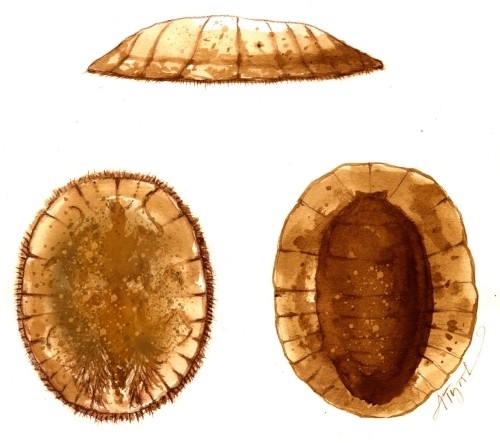
Imagine for a moment that you travel on all fours like other self-respecting quadrupeds. Extend your imagination yet a little more, and with it your body, so that a large dome-shaped shell-like structure extends out to cover you in all directions. From above, a predator would see only a disk with a snug fit to the ground on all sides. Now shrink dramatically and move into the nearest fast-flowing stream: you are well on your way to becoming a water penny beetle larva.
If you consider the characteristics just described as distinctly non-beetle like, you are not alone. The same notion struck the 19th century biologist who first peeled one off a rock and sat back to classify it. His confusion created a minor kerfuffle in the scientific literature that leaves a lasting legacy.
As the name suggests, water pennies are about the diameter of a US or Canadian penny. But diameter and near circular shape is where the analogy ends. Water pennies are not nearly as thick as a penny, and this flatness allows for their survival in a fairly hostile environment.
Water pennies are found on rocks in flowing water. But the flow that discourages silt from fouling their habitat also presents the constant risk of being washed downstream. Luckily for water pennies, flow is not the same everywhere, evening in the fastest flowing stream.
The deepest and fastest part of a river or stream is called the thalweg. Often it’s in the center, but rivers turn, loop, and meander, so the thalweg’s exact position is unpredictable and shifts over time.
Evolution has prepared water pennies very well for these hazards. Getting away from the thalweg, riverbed friction slows water velocity dramatically the closer one gets to the rocky riverbed. In fact, on riverbed rocks there exists a thin layer of water with virtually zero water movement. This peaceful haven just below the chaos is called the ‘boundary layer.’
A water penny’s low profile allows it to live almost entirely in the still-water boundary layer. Because the edge of a water penny’s disk slopes down toward the rocky surface, water flowing over the larva would tend to exert some downward pressure even when the beetle ventures to more exposed rocky surfaces. The larvae eke out a living by grazing on periphyton, the complex mixture of algae, bacteria, and fungi that grows on rocky surfaces. Because of this combination of diet and habitat use, they thrive in flowing water.
These beetle larvae found a unique solution to surviving river conditions, oblivious to the confusion they might cause for scientists. A disk-like shape certainly does not scream ‘insect,’ much less ‘beetle,’ and so when water pennies were first described by James Ellsworth DeKay in 1844, he did not place them with the insects. In fact, he made the bold choice of placing Fluvicola herricki, as he named his newly described species, among the Isopoda along with pill bugs, roly pollies, and woodlice. It’s not as though he miscounted the legs; in fact he made it very clear in his description: “feet three pair.” He was however, at a distinct disadvantage: he had never seen an adult water penny. I sampled streams for nearly a decade before I saw one, so I forgive the esteemed Dr. DeKay his oversight. Besides, his was far from the only confusion.
Dr. John L. LeConte claimed the water pennies for the insects in 1849, naming them in honor of his father, with whom he shared a last name. And so the new scientific name became Eurypalpus lecontei, but not for long. Samuel Stehman Haldeman changed the name to Psephenus lecontei in 1853 because the name Eurypalpus was already in use for a genus of true flies. (To make things even more confusing, Fluvicola – the original genus name – already applied to a group of birds.) These scientists would have loved a quick Google search.
Finally, Charles Leng and Andrew Mutchler in 1927 renamed the species Psephenus herricki because DeKay’s species name took precedent over LeConte’s; no disrespect intended to him or his father. This is the name we use today, and so if you peel a water penny off a rock, you can proudly tell your friends you have found Psephenus herricki, a true water penny! Unless of course you found a false water penny…perhaps a story for another day?

